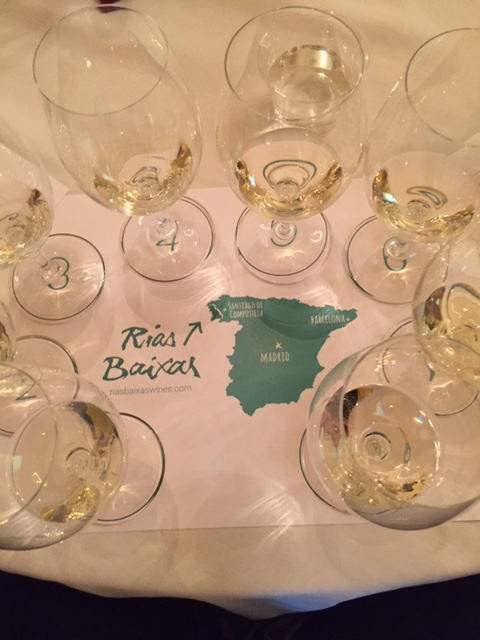“I’m ready for a new wine experience.”
This came from a friend who loves white wine, refuses to even smell my reds, and now she insists that Pinot Grigio, Riesling and Sauvignon Blanc all taste the same these days. (They don’t, but I let her go on with her rant.) “Is there another white I’d like?”

I had the perfect remedy for her wine boredom. Thanks to the good people at Rías Baixas Wines and wine discovery website Snooth, I had two bottles of Albariño in the fridge, just waiting for me to crack them.
This lip-smacking white, called “racy but not sharp” by one reviewer, is produced in the Rías Baixas DO, a tiny wine region in Galicia, the part of northwest Spain adjacent to Portugal. It’s believed that the Albariño grape was brought there in the 12th century by Cluny monks, who migrated from Burgundy in France. A small number of Portuguese winemakers also grow Albariño; on their side of the border it’s called Alvarinho. They sometimes use it to make Vinho Verde (translated: “green wine”), a dry, fruity-light wine with just a touch of deliberate frizzante, or effervescence.
Albariño is watery-yellow in appearance; if you were reviewing it for a major wine magazine you might refer to it as “pale straw”–a perfect description but not one that would occur to most people. (When was the last time you looked at straw close-up?)
If you’re a fan of Spanish wines, you probably drink a lot of Tempranillo, an easy-to-drink red and Spain’s most popular wine. It’s also one of the more affordable quality wines on the shelves. You’re likely to find Albariño costs a bit more, partly because this thin-skinned grape doesn’t hang on the vine as long as many varieties, so it produces less juice.
Still, Albariño accounts for nearly all of the grapes grown in Rías Baixas (96 percent), a region where about 99 percent of all wine produced is white. But don’t expect them to all taste the same. The government permits 12 grape varieties in that corner of Spain, and although the wines all are dry, there’s a diversity between them because of the different terroirs, grapes used in the blends, and microclimates in Rías Baixas’s five sub-zones.
Even in the vineyard, Albariño stands out. It’s grown on trellises called “parra” that stretch up to seven feet, preventing mildew and giving the fruit more sun exposure to encourage a more even ripening. By harvest time, the grapevines have formed a gorgeous canopy overhead.
When you buy Albariño, plan to drink it soon; it’s a delicate grape that will lose its fruit quickly. I’d give it a year or two at the most.
Wine Lingo: Capsule = the wrapping, often metal, that protects the cork and neck of a wine bottle, also referred to as the “foil.” Traditionally capsules were lead, but now you find them made of aluminum, plastic, tin, laminates or beeswax.

Vino ‘View: Yep, you’re looking at two dead soldiers in this photo: Marqués de Frias Albariño 2017 (12.5 percent alcohol) and Santiago Ruiz 2017 (13 percent alcohol, $21). Here’s something to watch for when you buy this wine: you’ll see that the label on the Marqués de Frias bottle announces that the wine is Albariño. It’s earned the right to do that because the wine is 100 percent Albariño, with no other grapes involved in making it, while the Santiago Ruiz is a blend. Spanish law says that, in order to use the word “Albariño” on the front label, it must be the only grape in the wine. Regardless, both bottles were delicious with strong minerality from the granite bedrock found throughout Rías Baixas. The Santiago Ruiz gave the stronger rocky taste, along with apple cider, roasted pear and a subtle licorice aroma. I got a slightly bitter aftertaste, but it was pleasant–it seemed to keep the cooked pear and stone fruit from taking over. The Marqués de Frias provided more of the lime, grapefruit and green apple tastes I expected–a persistent citrus tone that folded into tart cantaloupe by the second glass. Overall I thought it tasted young and rich–two positives!
[The Marqués de Frias and Santiago Ruiz were provided to BigSexyReds for review.]
Cheers!
Mary


